PPMP20013 Project Management Online Test Solution - Term 1, 2018
VerifiedAdded on 2023/06/11
|6
|1984
|176
Homework Assignment
AI Summary
This document presents a solved online test for the PPMP20013 Project Management course, taken in Term 1, 2018. The test comprises of multiple questions addressing key project management concepts. The solutions cover topics such as the roles and responsibilities of large asset owners, the tendering process and specifications, governance in projects, contract management, project cost estimation, quality assurance by asset owners, arbitration procedures, and considerations for safety and sustainability in project execution. The answers provide insights into practical scenarios and theoretical frameworks relevant to project management within large organizations. The document references academic sources to support the explanations and approaches to the questions posed in the test.
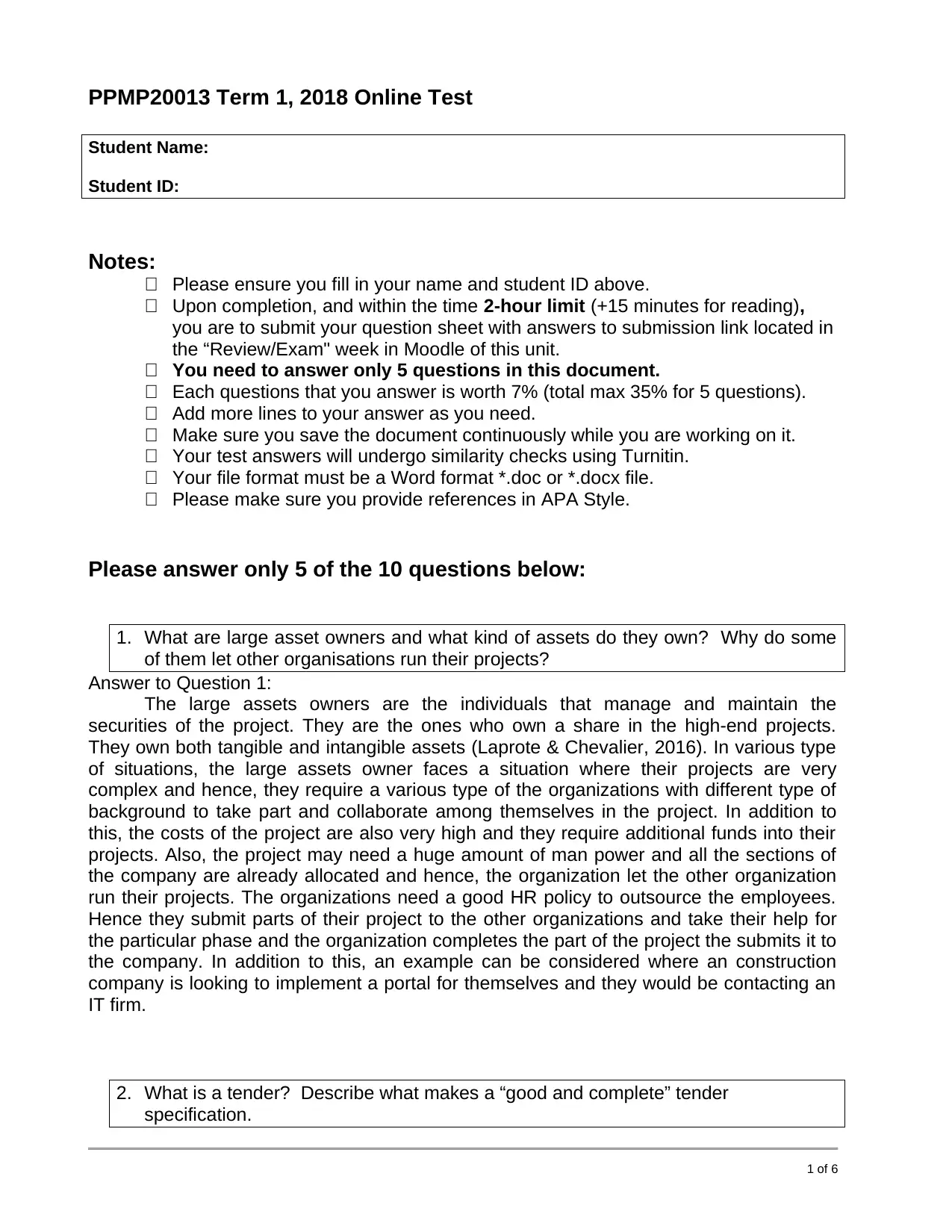
PPMP20013 Term 1, 2018 Online Test
Student Name:
Student ID:
Notes:
Please ensure you fill in your name and student ID above.
Upon completion, and within the time 2-hour limit (+15 minutes for reading),
you are to submit your question sheet with answers to submission link located in
the “Review/Exam" week in Moodle of this unit.
You need to answer only 5 questions in this document.
Each questions that you answer is worth 7% (total max 35% for 5 questions).
Add more lines to your answer as you need.
Make sure you save the document continuously while you are working on it.
Your test answers will undergo similarity checks using Turnitin.
Your file format must be a Word format *.doc or *.docx file.
Please make sure you provide references in APA Style.
Please answer only 5 of the 10 questions below:
1. What are large asset owners and what kind of assets do they own? Why do some
of them let other organisations run their projects?
Answer to Question 1:
The large assets owners are the individuals that manage and maintain the
securities of the project. They are the ones who own a share in the high-end projects.
They own both tangible and intangible assets (Laprote & Chevalier, 2016). In various type
of situations, the large assets owner faces a situation where their projects are very
complex and hence, they require a various type of the organizations with different type of
background to take part and collaborate among themselves in the project. In addition to
this, the costs of the project are also very high and they require additional funds into their
projects. Also, the project may need a huge amount of man power and all the sections of
the company are already allocated and hence, the organization let the other organization
run their projects. The organizations need a good HR policy to outsource the employees.
Hence they submit parts of their project to the other organizations and take their help for
the particular phase and the organization completes the part of the project the submits it to
the company. In addition to this, an example can be considered where an construction
company is looking to implement a portal for themselves and they would be contacting an
IT firm.
2. What is a tender? Describe what makes a “good and complete” tender
specification.
1 of 6
Student Name:
Student ID:
Notes:
Please ensure you fill in your name and student ID above.
Upon completion, and within the time 2-hour limit (+15 minutes for reading),
you are to submit your question sheet with answers to submission link located in
the “Review/Exam" week in Moodle of this unit.
You need to answer only 5 questions in this document.
Each questions that you answer is worth 7% (total max 35% for 5 questions).
Add more lines to your answer as you need.
Make sure you save the document continuously while you are working on it.
Your test answers will undergo similarity checks using Turnitin.
Your file format must be a Word format *.doc or *.docx file.
Please make sure you provide references in APA Style.
Please answer only 5 of the 10 questions below:
1. What are large asset owners and what kind of assets do they own? Why do some
of them let other organisations run their projects?
Answer to Question 1:
The large assets owners are the individuals that manage and maintain the
securities of the project. They are the ones who own a share in the high-end projects.
They own both tangible and intangible assets (Laprote & Chevalier, 2016). In various type
of situations, the large assets owner faces a situation where their projects are very
complex and hence, they require a various type of the organizations with different type of
background to take part and collaborate among themselves in the project. In addition to
this, the costs of the project are also very high and they require additional funds into their
projects. Also, the project may need a huge amount of man power and all the sections of
the company are already allocated and hence, the organization let the other organization
run their projects. The organizations need a good HR policy to outsource the employees.
Hence they submit parts of their project to the other organizations and take their help for
the particular phase and the organization completes the part of the project the submits it to
the company. In addition to this, an example can be considered where an construction
company is looking to implement a portal for themselves and they would be contacting an
IT firm.
2. What is a tender? Describe what makes a “good and complete” tender
specification.
1 of 6
Paraphrase This Document
Need a fresh take? Get an instant paraphrase of this document with our AI Paraphraser
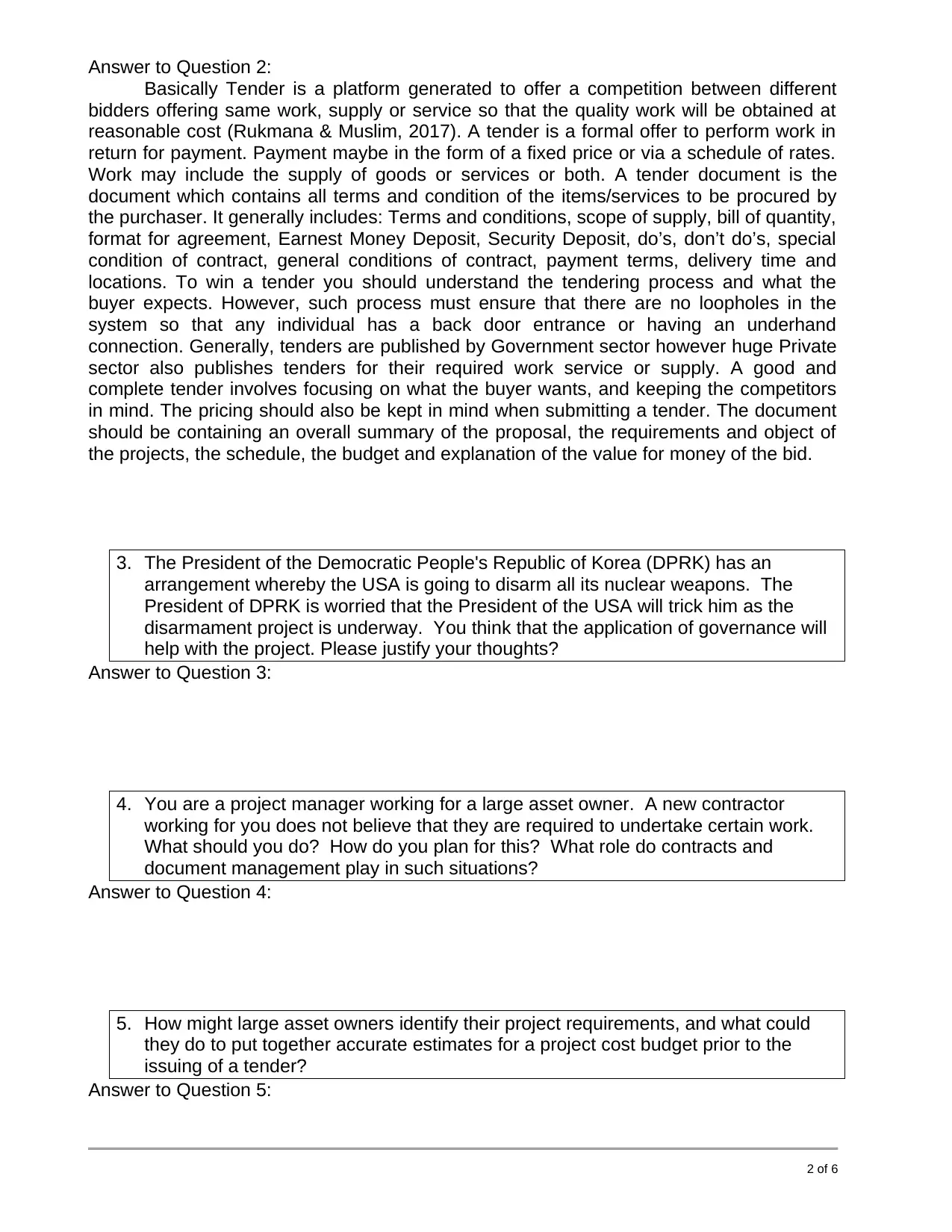
Answer to Question 2:
Basically Tender is a platform generated to offer a competition between different
bidders offering same work, supply or service so that the quality work will be obtained at
reasonable cost (Rukmana & Muslim, 2017). A tender is a formal offer to perform work in
return for payment. Payment maybe in the form of a fixed price or via a schedule of rates.
Work may include the supply of goods or services or both. A tender document is the
document which contains all terms and condition of the items/services to be procured by
the purchaser. It generally includes: Terms and conditions, scope of supply, bill of quantity,
format for agreement, Earnest Money Deposit, Security Deposit, do’s, don’t do’s, special
condition of contract, general conditions of contract, payment terms, delivery time and
locations. To win a tender you should understand the tendering process and what the
buyer expects. However, such process must ensure that there are no loopholes in the
system so that any individual has a back door entrance or having an underhand
connection. Generally, tenders are published by Government sector however huge Private
sector also publishes tenders for their required work service or supply. A good and
complete tender involves focusing on what the buyer wants, and keeping the competitors
in mind. The pricing should also be kept in mind when submitting a tender. The document
should be containing an overall summary of the proposal, the requirements and object of
the projects, the schedule, the budget and explanation of the value for money of the bid.
3. The President of the Democratic People's Republic of Korea (DPRK) has an
arrangement whereby the USA is going to disarm all its nuclear weapons. The
President of DPRK is worried that the President of the USA will trick him as the
disarmament project is underway. You think that the application of governance will
help with the project. Please justify your thoughts?
Answer to Question 3:
4. You are a project manager working for a large asset owner. A new contractor
working for you does not believe that they are required to undertake certain work.
What should you do? How do you plan for this? What role do contracts and
document management play in such situations?
Answer to Question 4:
5. How might large asset owners identify their project requirements, and what could
they do to put together accurate estimates for a project cost budget prior to the
issuing of a tender?
Answer to Question 5:
2 of 6
Basically Tender is a platform generated to offer a competition between different
bidders offering same work, supply or service so that the quality work will be obtained at
reasonable cost (Rukmana & Muslim, 2017). A tender is a formal offer to perform work in
return for payment. Payment maybe in the form of a fixed price or via a schedule of rates.
Work may include the supply of goods or services or both. A tender document is the
document which contains all terms and condition of the items/services to be procured by
the purchaser. It generally includes: Terms and conditions, scope of supply, bill of quantity,
format for agreement, Earnest Money Deposit, Security Deposit, do’s, don’t do’s, special
condition of contract, general conditions of contract, payment terms, delivery time and
locations. To win a tender you should understand the tendering process and what the
buyer expects. However, such process must ensure that there are no loopholes in the
system so that any individual has a back door entrance or having an underhand
connection. Generally, tenders are published by Government sector however huge Private
sector also publishes tenders for their required work service or supply. A good and
complete tender involves focusing on what the buyer wants, and keeping the competitors
in mind. The pricing should also be kept in mind when submitting a tender. The document
should be containing an overall summary of the proposal, the requirements and object of
the projects, the schedule, the budget and explanation of the value for money of the bid.
3. The President of the Democratic People's Republic of Korea (DPRK) has an
arrangement whereby the USA is going to disarm all its nuclear weapons. The
President of DPRK is worried that the President of the USA will trick him as the
disarmament project is underway. You think that the application of governance will
help with the project. Please justify your thoughts?
Answer to Question 3:
4. You are a project manager working for a large asset owner. A new contractor
working for you does not believe that they are required to undertake certain work.
What should you do? How do you plan for this? What role do contracts and
document management play in such situations?
Answer to Question 4:
5. How might large asset owners identify their project requirements, and what could
they do to put together accurate estimates for a project cost budget prior to the
issuing of a tender?
Answer to Question 5:
2 of 6
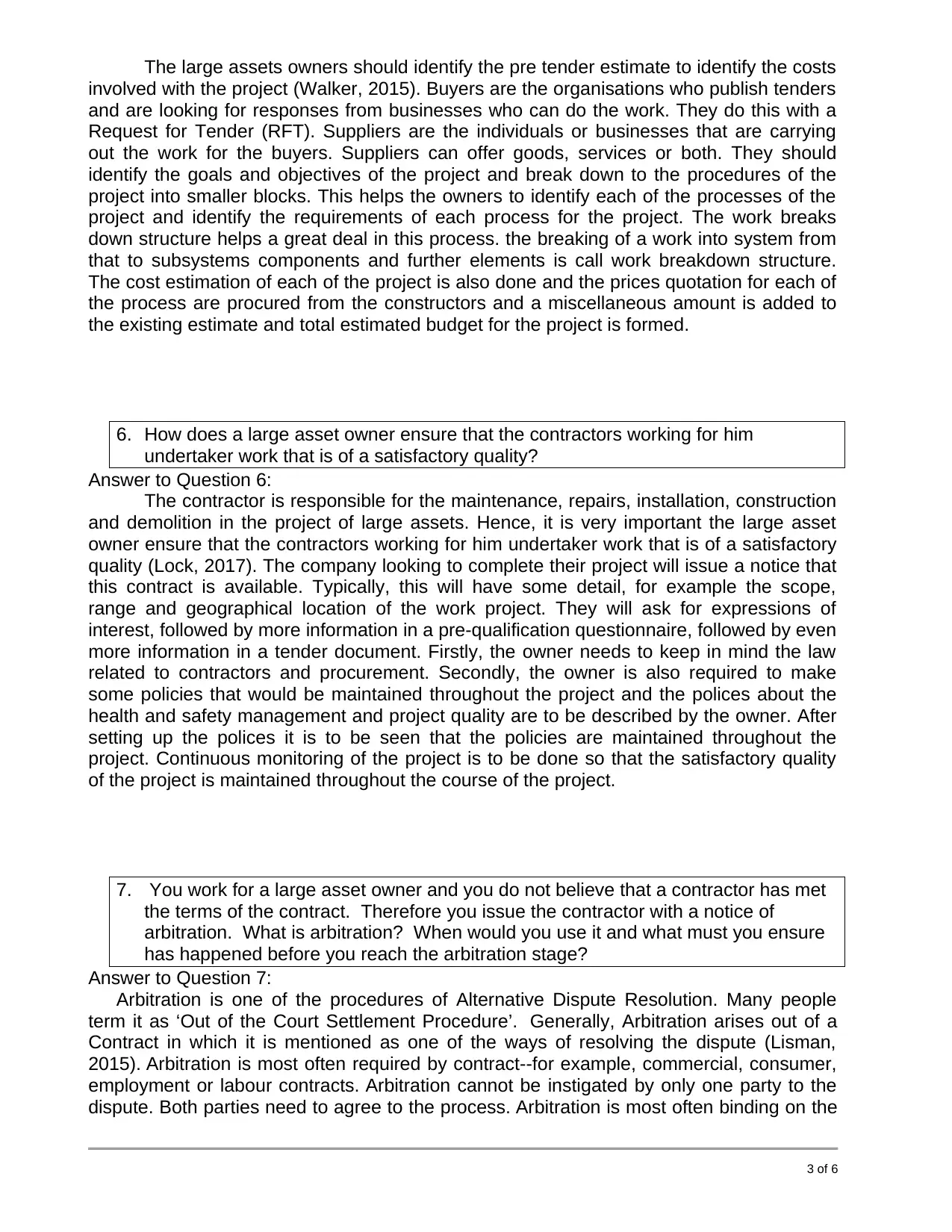
The large assets owners should identify the pre tender estimate to identify the costs
involved with the project (Walker, 2015). Buyers are the organisations who publish tenders
and are looking for responses from businesses who can do the work. They do this with a
Request for Tender (RFT). Suppliers are the individuals or businesses that are carrying
out the work for the buyers. Suppliers can offer goods, services or both. They should
identify the goals and objectives of the project and break down to the procedures of the
project into smaller blocks. This helps the owners to identify each of the processes of the
project and identify the requirements of each process for the project. The work breaks
down structure helps a great deal in this process. the breaking of a work into system from
that to subsystems components and further elements is call work breakdown structure.
The cost estimation of each of the project is also done and the prices quotation for each of
the process are procured from the constructors and a miscellaneous amount is added to
the existing estimate and total estimated budget for the project is formed.
6. How does a large asset owner ensure that the contractors working for him
undertaker work that is of a satisfactory quality?
Answer to Question 6:
The contractor is responsible for the maintenance, repairs, installation, construction
and demolition in the project of large assets. Hence, it is very important the large asset
owner ensure that the contractors working for him undertaker work that is of a satisfactory
quality (Lock, 2017). The company looking to complete their project will issue a notice that
this contract is available. Typically, this will have some detail, for example the scope,
range and geographical location of the work project. They will ask for expressions of
interest, followed by more information in a pre-qualification questionnaire, followed by even
more information in a tender document. Firstly, the owner needs to keep in mind the law
related to contractors and procurement. Secondly, the owner is also required to make
some policies that would be maintained throughout the project and the polices about the
health and safety management and project quality are to be described by the owner. After
setting up the polices it is to be seen that the policies are maintained throughout the
project. Continuous monitoring of the project is to be done so that the satisfactory quality
of the project is maintained throughout the course of the project.
7. You work for a large asset owner and you do not believe that a contractor has met
the terms of the contract. Therefore you issue the contractor with a notice of
arbitration. What is arbitration? When would you use it and what must you ensure
has happened before you reach the arbitration stage?
Answer to Question 7:
Arbitration is one of the procedures of Alternative Dispute Resolution. Many people
term it as ‘Out of the Court Settlement Procedure’. Generally, Arbitration arises out of a
Contract in which it is mentioned as one of the ways of resolving the dispute (Lisman,
2015). Arbitration is most often required by contract--for example, commercial, consumer,
employment or labour contracts. Arbitration cannot be instigated by only one party to the
dispute. Both parties need to agree to the process. Arbitration is most often binding on the
3 of 6
involved with the project (Walker, 2015). Buyers are the organisations who publish tenders
and are looking for responses from businesses who can do the work. They do this with a
Request for Tender (RFT). Suppliers are the individuals or businesses that are carrying
out the work for the buyers. Suppliers can offer goods, services or both. They should
identify the goals and objectives of the project and break down to the procedures of the
project into smaller blocks. This helps the owners to identify each of the processes of the
project and identify the requirements of each process for the project. The work breaks
down structure helps a great deal in this process. the breaking of a work into system from
that to subsystems components and further elements is call work breakdown structure.
The cost estimation of each of the project is also done and the prices quotation for each of
the process are procured from the constructors and a miscellaneous amount is added to
the existing estimate and total estimated budget for the project is formed.
6. How does a large asset owner ensure that the contractors working for him
undertaker work that is of a satisfactory quality?
Answer to Question 6:
The contractor is responsible for the maintenance, repairs, installation, construction
and demolition in the project of large assets. Hence, it is very important the large asset
owner ensure that the contractors working for him undertaker work that is of a satisfactory
quality (Lock, 2017). The company looking to complete their project will issue a notice that
this contract is available. Typically, this will have some detail, for example the scope,
range and geographical location of the work project. They will ask for expressions of
interest, followed by more information in a pre-qualification questionnaire, followed by even
more information in a tender document. Firstly, the owner needs to keep in mind the law
related to contractors and procurement. Secondly, the owner is also required to make
some policies that would be maintained throughout the project and the polices about the
health and safety management and project quality are to be described by the owner. After
setting up the polices it is to be seen that the policies are maintained throughout the
project. Continuous monitoring of the project is to be done so that the satisfactory quality
of the project is maintained throughout the course of the project.
7. You work for a large asset owner and you do not believe that a contractor has met
the terms of the contract. Therefore you issue the contractor with a notice of
arbitration. What is arbitration? When would you use it and what must you ensure
has happened before you reach the arbitration stage?
Answer to Question 7:
Arbitration is one of the procedures of Alternative Dispute Resolution. Many people
term it as ‘Out of the Court Settlement Procedure’. Generally, Arbitration arises out of a
Contract in which it is mentioned as one of the ways of resolving the dispute (Lisman,
2015). Arbitration is most often required by contract--for example, commercial, consumer,
employment or labour contracts. Arbitration cannot be instigated by only one party to the
dispute. Both parties need to agree to the process. Arbitration is most often binding on the
3 of 6
⊘ This is a preview!⊘
Do you want full access?
Subscribe today to unlock all pages.

Trusted by 1+ million students worldwide
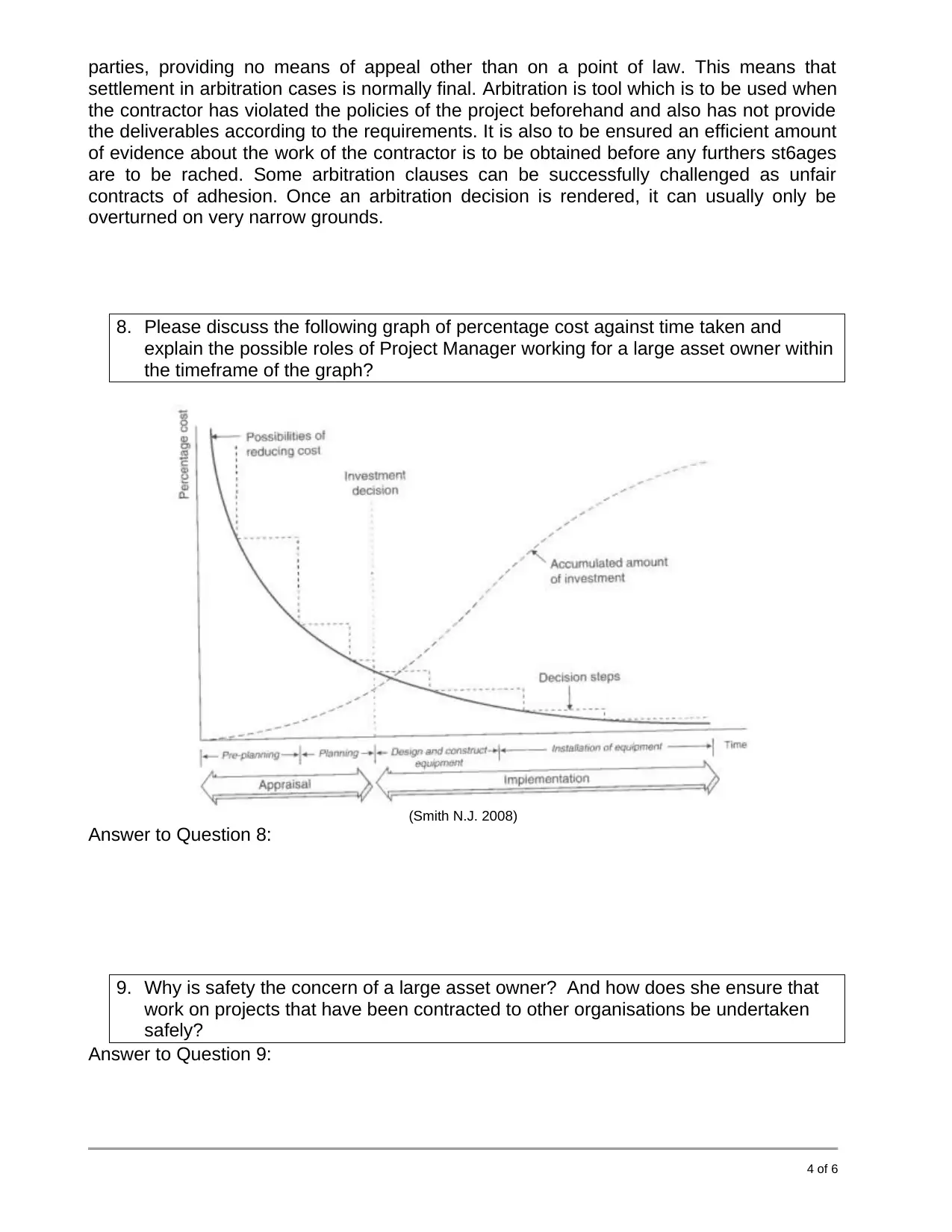
parties, providing no means of appeal other than on a point of law. This means that
settlement in arbitration cases is normally final. Arbitration is tool which is to be used when
the contractor has violated the policies of the project beforehand and also has not provide
the deliverables according to the requirements. It is also to be ensured an efficient amount
of evidence about the work of the contractor is to be obtained before any furthers st6ages
are to be rached. Some arbitration clauses can be successfully challenged as unfair
contracts of adhesion. Once an arbitration decision is rendered, it can usually only be
overturned on very narrow grounds.
8. Please discuss the following graph of percentage cost against time taken and
explain the possible roles of Project Manager working for a large asset owner within
the timeframe of the graph?
(Smith N.J. 2008)
Answer to Question 8:
9. Why is safety the concern of a large asset owner? And how does she ensure that
work on projects that have been contracted to other organisations be undertaken
safely?
Answer to Question 9:
4 of 6
settlement in arbitration cases is normally final. Arbitration is tool which is to be used when
the contractor has violated the policies of the project beforehand and also has not provide
the deliverables according to the requirements. It is also to be ensured an efficient amount
of evidence about the work of the contractor is to be obtained before any furthers st6ages
are to be rached. Some arbitration clauses can be successfully challenged as unfair
contracts of adhesion. Once an arbitration decision is rendered, it can usually only be
overturned on very narrow grounds.
8. Please discuss the following graph of percentage cost against time taken and
explain the possible roles of Project Manager working for a large asset owner within
the timeframe of the graph?
(Smith N.J. 2008)
Answer to Question 8:
9. Why is safety the concern of a large asset owner? And how does she ensure that
work on projects that have been contracted to other organisations be undertaken
safely?
Answer to Question 9:
4 of 6
Paraphrase This Document
Need a fresh take? Get an instant paraphrase of this document with our AI Paraphraser
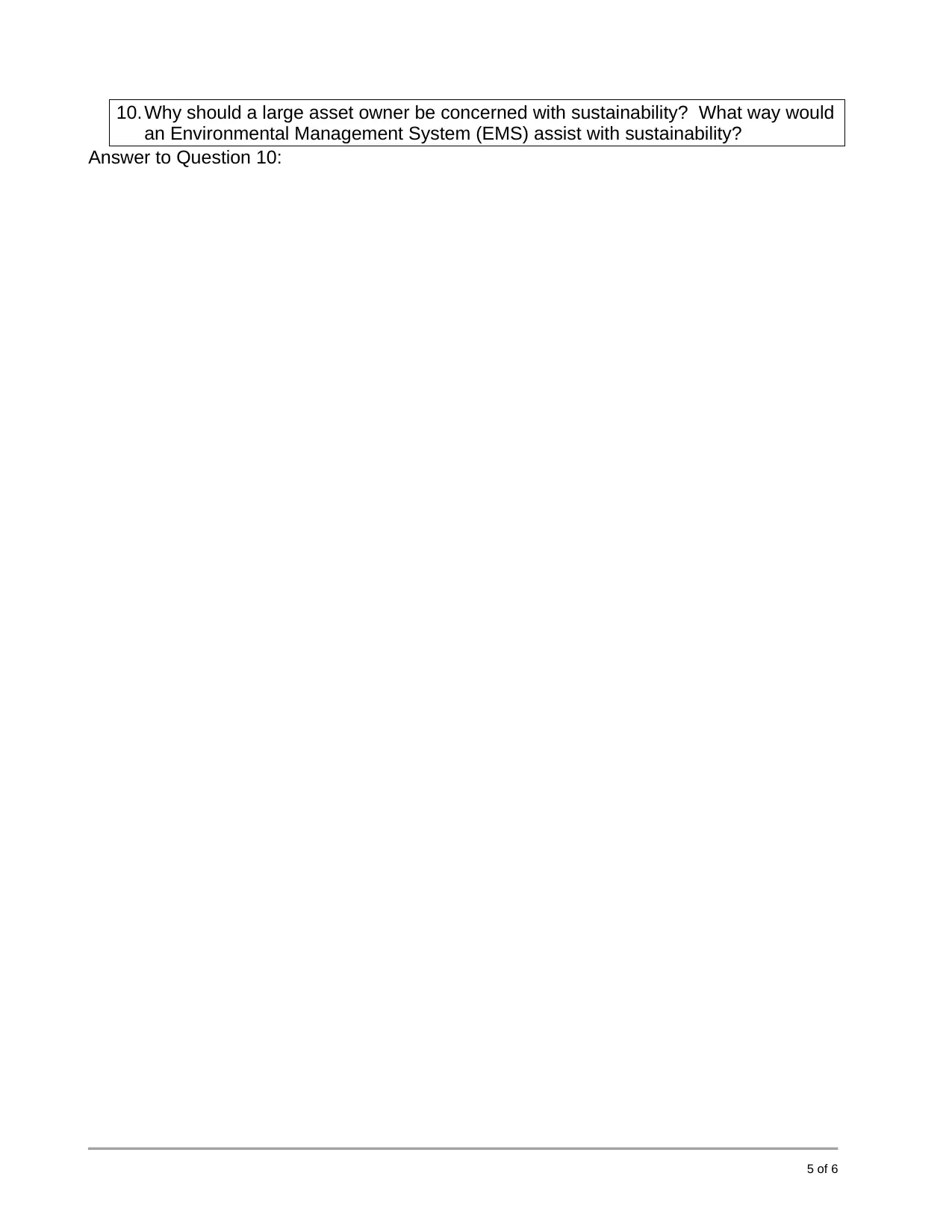
10. Why should a large asset owner be concerned with sustainability? What way would
an Environmental Management System (EMS) assist with sustainability?
Answer to Question 10:
5 of 6
an Environmental Management System (EMS) assist with sustainability?
Answer to Question 10:
5 of 6
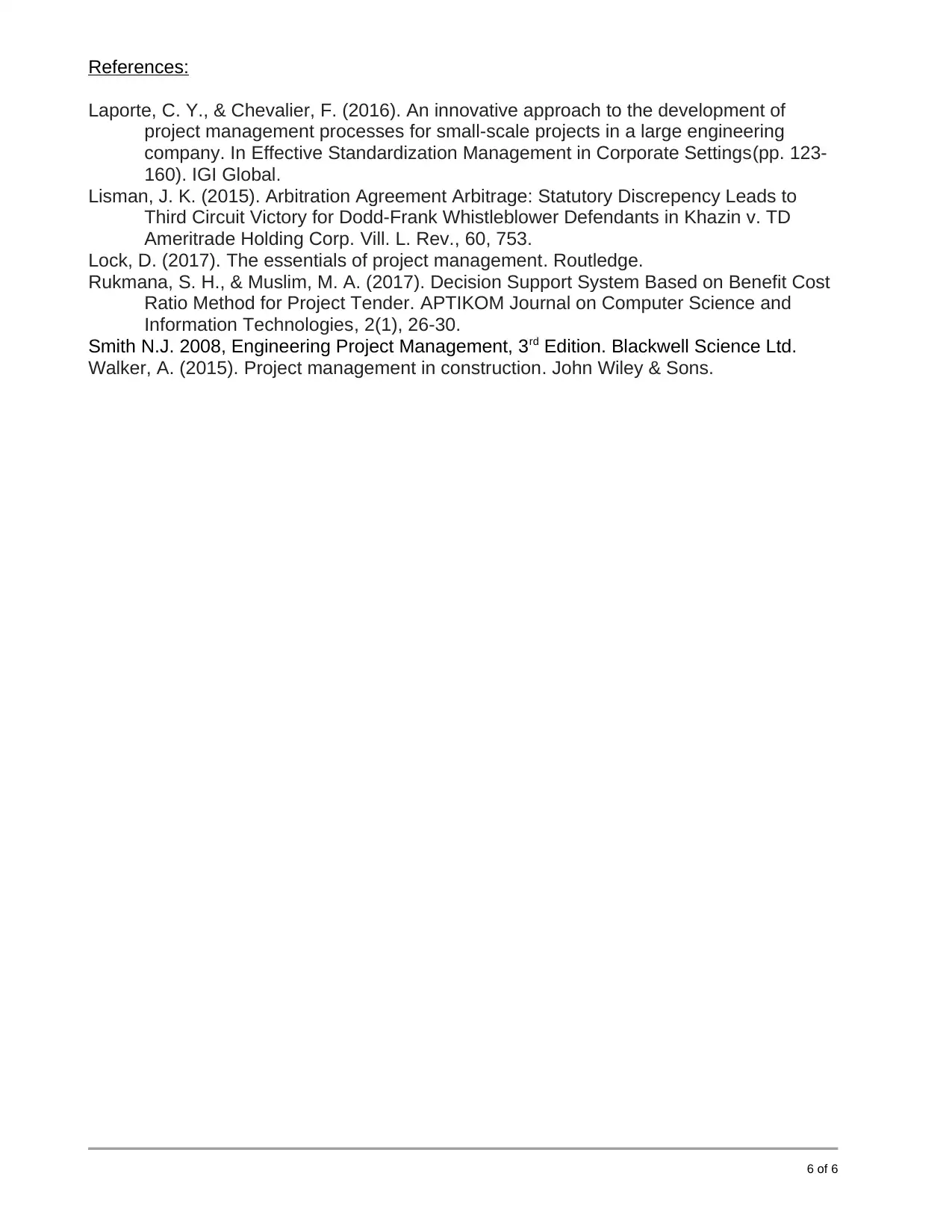
References:
Laporte, C. Y., & Chevalier, F. (2016). An innovative approach to the development of
project management processes for small-scale projects in a large engineering
company. In Effective Standardization Management in Corporate Settings(pp. 123-
160). IGI Global.
Lisman, J. K. (2015). Arbitration Agreement Arbitrage: Statutory Discrepency Leads to
Third Circuit Victory for Dodd-Frank Whistleblower Defendants in Khazin v. TD
Ameritrade Holding Corp. Vill. L. Rev., 60, 753.
Lock, D. (2017). The essentials of project management. Routledge.
Rukmana, S. H., & Muslim, M. A. (2017). Decision Support System Based on Benefit Cost
Ratio Method for Project Tender. APTIKOM Journal on Computer Science and
Information Technologies, 2(1), 26-30.
Smith N.J. 2008, Engineering Project Management, 3rd Edition. Blackwell Science Ltd.
Walker, A. (2015). Project management in construction. John Wiley & Sons.
6 of 6
Laporte, C. Y., & Chevalier, F. (2016). An innovative approach to the development of
project management processes for small-scale projects in a large engineering
company. In Effective Standardization Management in Corporate Settings(pp. 123-
160). IGI Global.
Lisman, J. K. (2015). Arbitration Agreement Arbitrage: Statutory Discrepency Leads to
Third Circuit Victory for Dodd-Frank Whistleblower Defendants in Khazin v. TD
Ameritrade Holding Corp. Vill. L. Rev., 60, 753.
Lock, D. (2017). The essentials of project management. Routledge.
Rukmana, S. H., & Muslim, M. A. (2017). Decision Support System Based on Benefit Cost
Ratio Method for Project Tender. APTIKOM Journal on Computer Science and
Information Technologies, 2(1), 26-30.
Smith N.J. 2008, Engineering Project Management, 3rd Edition. Blackwell Science Ltd.
Walker, A. (2015). Project management in construction. John Wiley & Sons.
6 of 6
⊘ This is a preview!⊘
Do you want full access?
Subscribe today to unlock all pages.

Trusted by 1+ million students worldwide
1 out of 6
Related Documents
Your All-in-One AI-Powered Toolkit for Academic Success.
+13062052269
info@desklib.com
Available 24*7 on WhatsApp / Email
![[object Object]](/_next/static/media/star-bottom.7253800d.svg)
Unlock your academic potential
Copyright © 2020–2025 A2Z Services. All Rights Reserved. Developed and managed by ZUCOL.





